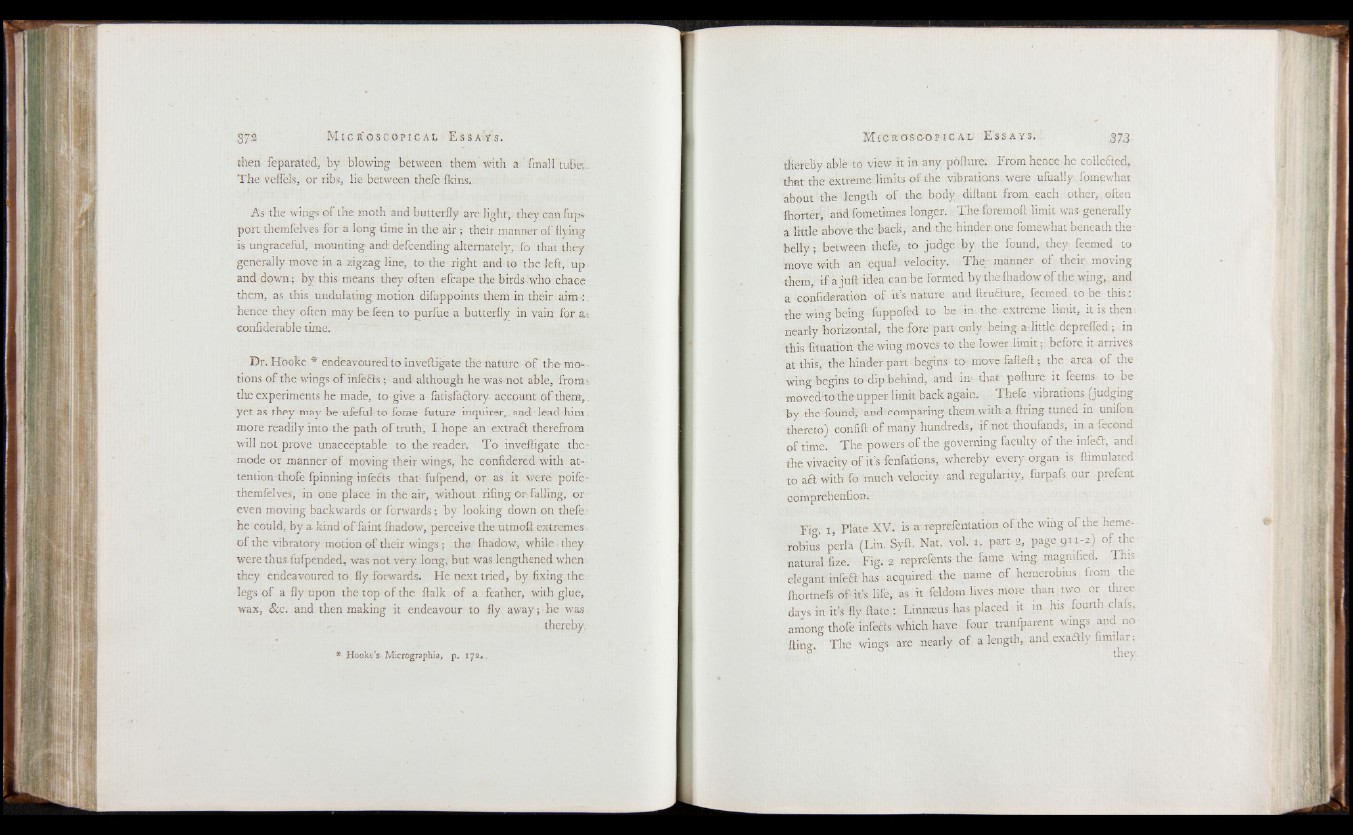
then feparated, by blowing between them with a final! tube..
The veflels, or ribs, lie between thefe Ikins.
As the wings of the moth and butterfly are light,, they can fup*
port themfelves for a long time in the air ; their manner of flying
is ungraceful, mounting and: defcending alternately, fo that they
generally move in a zigzag line, to the right and to The left, up
and down.; by this means they often efcape the birds .who chace
them, as this undulating motion difappoints them in their aim-;,
hence they often may be feen to purfue a butterfly in vain for a»
eonfiderahle time.
Dr. Hooke * endeavoured to inveftigate the nature of' the m o tions
of the wings of infefts; and although he was not able, from-,
the experiments he made, to give a fatisfaftory. account o f them-,.
yet as they may be -ufeful-to fome future inquirer, and lead him.
more readily into the path of truth, I hope an extraft therefrom
will not prove unacceptable to the reader. T o inveftigate the;
mode or manner of moving their wings, he confidered with attention
thofe fpinning infefts that fufpend, or as it were poife-
themfelves, in one place in the air, without riling o r falling, or
even moving backwards or forwards; by looking down on thele -
he could, by a- kind o f faint ftiadow, perceive the utmoft extremes.
o f the vibratory motion of their wings ; the lhadow-, while - they
were thus fufpended, was not very long, but was lengthened when,
they endeavoured to fly forwards. He next tried, by fixing the
legs o f a fly upon the top of the ftalk of a feather, with glue,
wax, See. and then making it endeavour to fly away; he was
thereby.
thereby able to view it in any pofture. From hence he collected,
that the extreme- limits of the vibrations were ufually, fomewhat
about the length o f the body diftant from each other, often
fhorter, and fometimes longer. The foremoft limit was generally
a little above-the-back, and the hinder, one fomewhat beneath the
b e lly ; between thefe, to judge by the found, they feemed to
move with an equal velocity. The; manner of their moving
them, if a juft idea can be formed by the lhadow o f the wing, and
a confideration of it’s nature and itrufcture, feemed To be this :
the wing being- fuppofed to be in. the extreme, limit, it is then
nearly horizontal, the fore part only being-adittle deprelfed ; in
this lituation the -wing moves to the lower, limit;; before it arrives
at this,- the hinder part begins- to move falteft; the area of the
wing begins to dip behind, and- in-- that pofture it feems- to be
moved-to the upper limit back again, Thefe vibrations (judging
by the-found; and-comparing them with a firing tuned in unifon
thereto) confift of many hundreds, if not thoufands, in a fecond
of time. T h e powers of the governing faculty of the infeft, and
the vivacity o f it’s fenfations, whereby every organ is ftimulated
to aH with fo much velocity and regularity, furpafs our prefent
comprehenfion.
Fig 1, Plate XV. is a-reprefentation of the wing of the heme-
robius perla (Lin. Syft. Na t.vol. i, part 2, page 911-2) of the
natural fize.- Fig, 2 reprefents-the fame wing, magnified. This
elegant infeS has acquired the name of hemerobius from the
Ihortnefs o f it’s life, as it feldom lives-more than Two or three
days in it’s fly ftate : Linnaeus has placed it in his fourth clafs,
among thofe infefts which have four tranfparent wings and no
fling. The wings are nearly o f a length, and exadly fimilar:
5 they